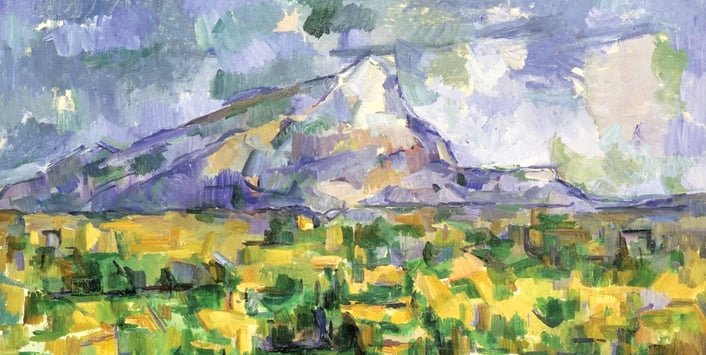
It was the art of Paul Cézanne, a fairly solitary man of independent means and independent thought that formed a basis for the development of modern art at the beginning of the twentieth century. The Impressionists had generated a new spontaneity, setting new parameters and effectively changing the way one perceived art, to capture the sensation and the immediacy of modern life. Cézanne, originally affiliated with the group and exhibiting twice with the Impressionists, wanted to ‘make of Impressionism something solid and enduring like the art of the museums’.
Letting Go of the Past
Cézanne initially aimed to imitate the artists that most inspired him, referencing in particular the Spanish ‘old masters’. However, these works seemed restricted. Inhibited by dark colour palettes and rigid, sculptural figures. Cézanne later recalled to Renoir that it had taken him 20 years to realize that painting was not sculpture. By 1886 his brushstrokes were short and measured to create a carefully constructed work, reflecting the essence of the subject.
He began to move away from Impressionism to develop his own perception of visual art, one based on formal structure and seeing the landscape, a portrait or a still life as a series of mass, volumes and planes. The paintings from these later years would be perceived as the foundation of abstract art. It was this simplification of natural forms that anticipated Cubism. From the 1890s Cézanne’s oeuvre began to be recognized. November 1894 saw the opening of a selling exhibition featuring around 50 – or possibly up to 150 – paintings and drawings by Cézanne. It was a success. Renoir, Monet and Degas all purchased works.
What we know of Cézanne’s theories on art come through letters he wrote to his son and to his artist friends. One friend in particular, a young French painter Émile Bernard, spent time with Cézanne at his home in Aix-en-Provence. They corresponded regularly. On 15 April 1904, in a letter written to Bernard, Cézanne shared his own theoretical analysis for painting:
Treat nature by means of the cylinder, the sphere, the cone, with everything put in perspective so that each side of an object or a plane is directed toward a central point. Lines parallel to the horizon convey the extent of a section of nature, or if you prefer, of the spectacle that the Pater Omnipotens Aeterne Deus [Omnipotent, Eternal Father God] spreads out before our eyes. Lines perpendicular to the horizon convey depth.
Now nature for us men, is more depth than surface, hence the need to introduce into our vibrations of light, represented by reds and yellows,a sufficient amount of blue, to make the air palpable.
- Paul Cézanne
This points to paring down natural forms into perceived volumes and depths to facilitate a modulated vision of the work, in landscape, portrait or still life. It has been quoted many times as the anticipatory pointer toward Cubism and Abstraction but Cézanne meant to illustrate how he perceived what he saw before him rather than an exercise in geometrical formulation. Cézanne, now considered the ‘father of modern art’, had many doubts about his work as letters to his friends reveal. He believed in painting from life, whether in the studio or outside. His painting method was to build up areas of the canvas in blocks of colour, layer upon layer. His canvases often had empty unpainted areas, which critics saw as unfinished.
Today's blog is a modified extract from our incredible book, Origins of Modern Art. To read the full-length text set alongside stunning modern art masterpieces, just click here.




